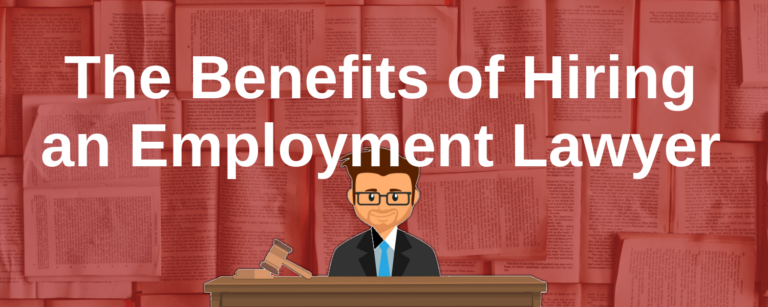
Justin W. Anisman is an Employment Lawyer and principal of Anisman Law. Justin advises both companies and individuals in all aspects of employment law including wrongful dismissal, human rights and discrimination.
Being fired or getting terminated for “just cause” is only one form of discipline available to Ontario employers. Often, though, termination for cause is too harsh in the circumstances and therefore not available as an option. It is important for both employees and employers to understand what other types of discipline are available and how to act in accordance with the principles of “progressive discipline”.
This article will be focusing on discipline in the workplace aside from termination. For more information on termination see one of my earlier articles: Termination of the Employment Relationship in Ontario » Legally Speaking.
Progressive discipline is a process used to deal with any job-related behaviour that does not meet expected and communicated standards or policies regarding job performance, absenteeism or lateness, or other minor misconduct. The primary purpose of the progressive discipline doctrine is to help an employee understand that a performance problem exists and to offer opportunities for improvement. The concept behind progressive discipline is that where an employee repeatedly fails to meet the expectations of the job, the disciplinary action against him will begin with mild correction action and gradually move to more serious actions as each incident occurs — eventually permitting an employer to terminate for cause.
The law does not require employment contracts to include the employer’s approach to progressive discipline however, best practices suggest an employer should set out their approach to progressive discipline in a well-written and well-communicated policy. In this regard, they are able to refer to it specifically as necessary.
Basic progressive discipline policy provides for four levels of discipline: verbal warning, written warning, suspension and termination. There is no one single approach applied — approaches vary depending on the company and collective bargaining agreement. For example, the discipline for a first offence may be counselling in one company yet a warning in another.
Overall, effective discipline helps to correct employee behavioural issues, increase productivity as well as help to protect a company against wrongful termination lawsuits.
Levels of disciplinary action are as follows:
Termination for cause should be considered as a last resort. It is challenging to prove terminations are justified and courts only do so in the clearest of circumstances. In exceptional circumstances, immediate termination for an act of significant or severe misconduct may be appropriate but in almost all cases, employers should be guided by the principle of progressive and corrective discipline.
Rather than straight dismissal, the goal of progressive discipline is correcting poor behaviour and creating a better and more productive employee.
In instances where an employee’s performance or conduct is at issue, the employer should clearly provide the employee with the following:
This process applies to any of the disciplinary action levels – i.e. Verbal or written warnings, performance improvement plans etc. Employers must give employees clear messages, actionable steps, assistance and reasonable time frames to show improvement during any stage of discipline.
Employee discipline is not about dominance or punishment. As a result, in most instances, discipline that is punitive is contrary to employment law. For example, withholding pay or suspending an employee without pay is not appropriate. Subjecting an employee to humiliation in front of coworkers, demotions or cuts in salary/pay are also considered inappropriate forms of discipline. Bullying usually involves repeated incidents or a pattern of behaviour that is intended to intimidate, offend, degrade or humiliate a particular person or group of people. It has also been described as the assertion of power through aggression. In this respect, it is punitive and not an appropriate form of discipline.
Suspension is a common form of punitive disciplinary action.
According to the Ontario Court of Appeal, an unpaid administrative suspension generally triggers a constructive dismissal “unless it (is) an express or implied term of the contract that the employer (can) suspend an employee without pay.”
The Courts will assess unpaid suspensions with a higher level of scrutiny than paid suspensions. Accordingly, employers should not impose unpaid suspensions unless they are expressly permitted to do so by a contract of employment or the circumstances are such that an unpaid suspension is reasonable. In other words, if an employer imposes an administrative suspension that is neither expressly permitted by contract nor reasonable in the circumstances, they run the risk of liability for constructive dismissal damages.
Courts often look at whether the employee had the opportunity to challenge the suspension before the person who imposed the suspension in the first place. Failing to allow for this may render the suspension a constructive dismissal, wherein the employee may claim for notice for the termination of their employment and the potential for any unpaid wages during the suspension period.
A clear and well-drafted employment agreement or workplace policies and handbooks regarding suspensions will provide both the employer and employee with information on their rights.
Courts and tribunals expect employers to apply disciplinary measures fairly and consistently, taking into account any specific circumstances of the situation on a case-by-case basis.
Aside from the strict facts of the case, adjudicators consider both “aggravating” and “mitigating” factors in determining the most appropriate type and severity of disciplinary action — especially when an action as serious as dismissal is being considered. Arbitrators weigh the presence, or absence, of mitigating factors in deciding whether to uphold, reduce or rescind a disciplinary sanction.
Some examples of employee related factors that affect the level of disciplinary action taken include the following:
Examples of some of the case related factors adjudicators consider are as follows:
Policies communicate expectations to staff and guarantee that fair and consistent treatment is served to all. It is important for staff to know from the start what is expected and how their performance will be addressed should it fall short of workplace standards. Policies hold everyone accountable and need to be supported by accompanying procedures.
The following are procedures to support progressive discipline:
Suggested steps:
Termination of staff should be considered a last resort. The incorporation of progressive discipline in the form of policies, procedures and practices can provide effective corrective strategies to mitigate many behaviour issues and avoid disputes being taken to court. Progressive discipline is a doctrine upheld by Ontario courts, which should be part of a company policy and should be clearly communicated and adhered to.

Justin W. Anisman is an Employment Lawyer and principal of Anisman Law. Justin advises both companies and individuals in all aspects of employment law including wrongful dismissal, human rights and discrimination.
Contact Justin W. Anisman, the author of this blog, about any employment law related questions or issues you may be facing.
Employment Standards & ComplianceWrongful Dismissal & Termination
Justin W. Anisman can be reached by phone or email 24 hours a day and is always available for a free in person or telephone consultation.